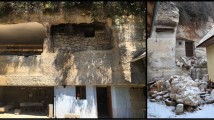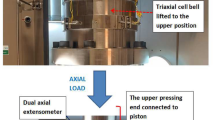Abstract
Pore-structure poses great influence on the permeability and electrical property of tight sand reservoirs and is critical to the petrophysical research of such reservoirs. The uncertainty of permeability for tight sands is very common and the relationship between porestructure and electrical property is often unclear. We propose a new parameter δ, integrating porosity, maximum radius of connected pore-throats, and sorting degree, for investigating the permeability and electrical properties of tight sands. Core data and wireline log analyses show that this new δ can be used to accurately predict the tight sands permeability and has a close relation with electrical parameters, allowing the estimation of formation factor F and cementation exponent m. The normalization of the resistivity difference caused by the porestructure is used to highlight the influence of fluid type on Rt, enhancing the coincidence rate in the Pickett crossplot significantly.
Similar content being viewed by others
References
Faruk, C., 2002, Relating permeability to pore connectivity using a power-law flow unit equation: Petrophysics, 43(6), 457–475.
Gao, M., An, X. R., Di, S. H., Li, Z. L., Peng, Y., Gao, X., and Yu, P. Z., 2000, Evaluating porous structure of reservoir with MRIL data: Well Logging Technology, 24(3), 188–193.
Hao, M. Q., Liu, X. Q., Hu, Y. L., Yang, Z. M., and Hou, J. F., 2007, Reservoir characteristics of micro-fractured ultra-low permeability reservoirs: ACTA Petrolei Sinica, 28(5), 93–98.
He Y. D., Mao, Z. Q., Xiao, L. Z., and Zhang, Y. Z., 2005, A new method to obtain capillary pressure curve using NMR T2 distribution: Journal of Jilin University (Earth Science Edition), 35(2), 177–181.
Hodgkins, M. A., and Howard, J. J., 1999, Application of NMR logging to reservoir characterization of low-resistivity sands in the Gulf of Mexico: AAPG Bulletin, 83(1), 114–127.
Hofman, J. P., Looyestijn, W. J., Slijkerman, F. J., and Yakov, V., 2001, A practical approach to obtain primary drainage capillary pressure curves from NMR core and log data: Petrophysics, 42(4), 334–343.
Li, H. B., Zhu, J. Y., and Guo, H. K., 2008, Methods for calculating pore radius distribution in rock from NMR T2 spectra: Chinese Journal Of Magnetic Resonance, 25(2), 273–279.
Li, T. J., Li, Z. F., and Zhao, Y. C., 2006, Consistency of pore structures between NMR and mercury intrusion method: Natural Gas Industry, 26(10), 57–59.
Li, Y., Fang, Y. R., Deng, S. G., and Liu, B. K, 2008, Experimental study of pore structure with nuclear magnetic resonance: Progress In Exploration Geophysics, 31(2), 129–132.
Luo, Z.T., and Wang, Y. C., 1986, Pore-structure of hydrocarbon reservoirs: Science Press, China.
Mao, Z. Q., and Gao, C. Q, 2000, Theoretical simulation of the resistivity and pore structure of hydrocarbon bearing rocks: Petroleum Exploration and Development, 27(2), 87–89.
Merkel, R., 2006, Integrated petrophysical models in tight gas sands: SPWLA Annual Symposium, Paper P.
Sun, J. M., Liu, X. F., and Wang, H. T., 2009, Improved numerical simulation of electrical properties of reservoir rocks using morphology: SPWLA Annual Symposium, Paper ZZZ.
Wang, Z. Z., and Xu, X. Q., 2010, Quantitative evaluation of reservoir separation with MR-ML technology: Chinese Journal of Magnetic Resonance, 27(2), 214–220.
Wang, Z. Z., Yardenia, M., Kurt, S., and Yu, G., 2007, The practical application of NMR logging in carbonates: 3 case studies: SPWLA Annual Symposium, Paper X.
Wang, Z. R., and Wu, D. X., 2001, Concentrative function and its primary application: ACTA Oceanologica Sinica, 23(2), 40–45.
Xiao, L., Mao, Z. Q., Xiao, Z. X., and Zhang, C., 2008, A new method to evaluate reservoir pore structure consecutively using NMR and capillary pressure data: SPWLA Annual Symposium, Paper AA.
Yun, H. Y., Zhao, W. J., Liu, B. K., Zhou, C. C., and Zhou, F. M., 2002, Researching rock pore structure with T2 distribution: Well Logging Technology, 26(1), 18–21.
Zhang, L. H., Zhou, C. C., Liu, G. Q., Xiu, L. J., Li, C. X., and Liu, Z. H., 2006, Influence of pore structures on electric properties and well logging evaluation in low porosity and permeability reservoirs: Petroleum Exploration and Development, 33(6), 671–676.
Zhao, J., Jiang, Y. Z., Wang, W. N., and Tong, M. S., 2003, Investigation of rock pore structure using NMR technology: Well Logging Technology, 27(3), 185–188.
Author information
Authors and Affiliations
Additional information
This work is supported by Major National Oil & Gas Specific Project (Grant No. 2008ZX05020-001)
Li Chao-Liu is a senior log analyst at the Research Institute of Petroleum E&P, PetroChina, Beijing (RIPED). He received his MS degree in geophysics from RIPED in 1999. He obtained his PhD degree in Petroleum Geology in 2007. His research interests include log interpretation, petrophysics, and wireline log evaluation.
Rights and permissions
About this article
Cite this article
Li, CL., Zhou, CC., Li, X. et al. A novel model for assessing the pore structure of tight sands and its application. Appl. Geophys. 7, 283–291 (2010). https://doi.org/10.1007/s11770-010-0254-0
Received:
Revised:
Published:
Issue Date:
DOI: https://doi.org/10.1007/s11770-010-0254-0




